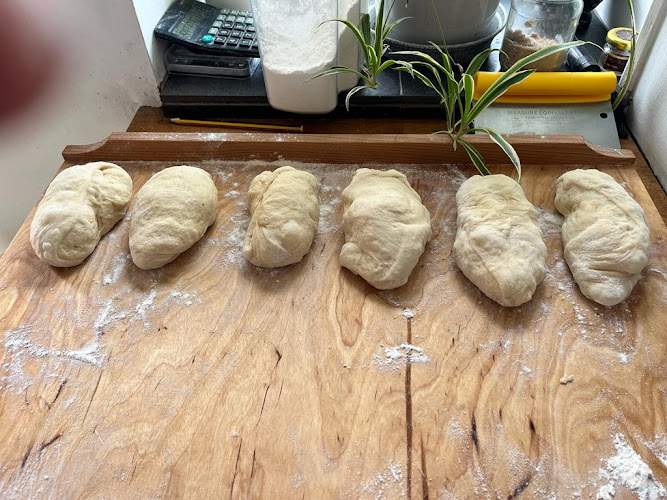Challah
Welcome to another step-by-step recipe from BreadClub20. Why not drop by our main Facebook page by clicking here.... If you like what you see and enjoy the recipe, we hope you join us by 'Liking' and 'Subscribing'.
Back in the 15th century, when Challah was first recorded as being braided, the bread was a simple affair. It is noted as being regularly baked in Austria and Southern Germany and the braiding seems to have started alongside the regular braiding of bread of non-Jewish housewives.
The shape and contents of Challah changed as people migrated and took their traditions with them. However, one thing is clear: the Challah of the American table is far sweeter than that of its European counterpart.
Challah is often the centrepiece when a Jewish family celebrates Shabbat and many traditional holidays.
'Challah' takes its name from the tradition of burning a portion of the dough in the fire.
In the Torah, God instructs Moses to set aside a portion of each loaf (1/24th) for the priest. This separation of the Challah is still undertaken today when a portion of the dough is taken aside and burnt on the fire or the oven.
On the eve of Shabbat, two loaves are often placed on the table to reference the Jewish teaching that a double portion of manna fell from heaven on the Friday to last through the Saturday Shabbat.
Traditionally, the braided Challah would form twelve 'humps'. each one representing one of the twelve ceremonial loaves kept in the Temple in Jerusalem for each of the tribes of Israel. However, it is not uncommon to find multi-plaited challah and also ones plaited into circles.
A note on the sugar content.
The European challah does not tend to be as sweet as that of its American counterpart. The quantity of sugar here is better suited to my European palate but, please feel free to adjust accordingly.
A note on the flour
For this recipe, I'm using strong white flour in keeping with the tradition of Eastern European Challah. However, it's not uncommon to find Challah made with spelt or whole-grain, especially among American Jewish families. You will also find many recipes that specify the use of a whole 5lb bag of flour. This is very traditional....but it produces a lot of loaves.
A further note
You will find recipes for Challah that use more eggs, some sweeten with honey and others add oil instead of some or all of the butter. You will find them using sourdough and including potato and raisins.
My interpretation here is quite basic, but easily managed. Once you master this, you may well wish to step off the path and start experimenting. However, I'd advise reading and research - after all, this is a very special bread with a good deal of history and culture behind it.
INGREDIENTS
500 gms strong white bread flour
200 gms tepid water
30 gms caster sugar
2 beaten eggs
75 gms unsalted butter
10 gms crushed rock salt (not iodised)
10 gms dried yeast
and for the glaze
1 egg yolk
15 gms warm water
poppy or nigella or sesame seeds
METHOD
1. Activate the yeast using a little of the water and a little of the sugar.
2. Mix the salt with the flour and then add the yeast mixture, the rest of the water, sugar, the melted butter and the beaten eggs.
3. Knead until you have a soft and silky dough.
4. Place in a lightly-oiled bowl, cover and leave in a warm place until it has doubled in volume.
5. Knock it back, recover the bowl and leave to rise once again for a further hour or so, until it has doubled once again.
6. Weigh the dough, gently tip it onto a lightly floured board and divide it into two. Then divide each half into three portions. Cover the portions with a cloth and leave to rest for 10 minutes. This will make the dough easier to work.
7. Three portions will be plaited into one challah. There's enough dough here for two challeh. Roll each portion into a rope about 12 - 15 inches long.
8. Lay three strands out and gently squeeze the three top ends together. Then, take the left strand and lay it over the middle, then take the right strand and lay it over the new left strand and keep repeating until you have plaited the whole of the dough.
9. Tuck the ends underneath and place on a prepared baking sheet.
10. Cover and leave to rise again in a warm place until it has doubled. Remember, because of the butter content, brioche takes far longer to rise than other breads.
11. Beat the egg yolk/water together and preheat the oven to 200⁰C.
12. Brush the risen dough with the egg yolk mixture and then sprinkle with poppy or nigella or sesame seeds.
13. Bake for 25 - 30 minutes until golden brown and hollow when tapped underneath.
14. Cool on a tray.
And from the taste testers
The Ashkenazi Challah is more of a savoury bread, ideal for lunch with a hunk of cheese and again very palatable with a deliciously light texture.
I think you should gather from that that we thoroughly enjoyed both so many, many thanks.
The traditional prayer when breaking the Challah...





.jpeg)





Comments
Post a Comment